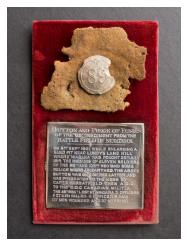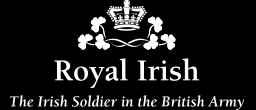89th Regiment at the Battle of Lundy's Lane, Canada

|
| Button on remnant of tunic fabric of the 89th unearthed near Lundy's Lane in 1891. |
During the Anglo-American War of 1812-15, the Americans invaded westwards across the River Niagara on 3 July 1814, captured Fort Erie and defeated Major General Riall's 5,000 strong British force in battle around Chippawa. The Americans then moved north along the west bank of the Niagara and threatened Fort George at Lake Ontario. The commander of the forces and governor general of Upper Canada (today's Ontario), Lieutenant General Gordon Drummond, moved his forces from Fort George to attack the American supply lines. Drummond, despite his rank and appointment as Lieutenant Governor of Upper Canada, had little real war fighting experience since his days as a battalion commander in Egypt.
On 23 July 1814, the 2/89th together with other troops advanced along the Niagara towards the enemy's forward base at Lewiston and discovered it was deserted. Meanwhile, Riall had fallen back four miles to Lundy's Lane (near Niagara Falls), and later, learning that the Americans were advancing towards him, began to withdraw his force of 1,800 north to Fort George. Drummond countered his order and moved rapidly to concentrate all his forces at Lundy's Lane.
The Americans started the battle at about 1800 hours when they tried to outflank the British left, a tactic which partially succeeded. The 2/89th stood firm and faced half left until the wavering militia could reform and continue to hold the left flank steady. After dusk, the battle continued into the night. The American main body attacked the British centre, but these 'repeated and determined attacks were met by the Eighty-Ninth Regiment ... with the most perfect steadiness and intrepid gallantry, and the enemy was repulsed with very heavy losses'.
Soon after 2100 hours, each side, having received reinforcements, continued the fighting. Volleys at close range and frequent bloody hand-to-hand fighting went on for over two hours, but still the Americans could not break the British line. The 2/89th played a predominant part in this stage of the battle and suffered very heavy losses when a counterattack failed to recapture lost British guns. At around midnight, the Americans retired exhausted back to Chippawa; the battle had lasted some five and a half hours. The British were too tired to pursue the enemy. The 2/89th had suffered about 254 casualties, including two officers and 27 men killed, - over fifty per-cent of its strength of 454. The 2/89th was no longer effective enough to fight and retired with its wounded to garrison Fort George.
Although both sides claimed a victory, it was the British who gained the strategic advantage as the American losses meant that the US was not able to pursue its war aim of seizing the northern Niagara forts held by the British. However, it was the bloodiest battle of the Anglo-American War on Canadian soil, resulting in some 900 US and 878 British declared casualties. In Drummond's General Order dated 26 July 1814, thanking the troops and militia for their actions, he recorded particular admiration for the 89th:
'The Lieutenant General cannot however refrain from expressing in the strongest manner his admiration of the gallantry and Steadiness of the 89th Regiment under Lieutenant Colonel Morrison, and Major Clifford who ably and Gallanty supported the Lieutenant Colonel's place after he was wounded.'





